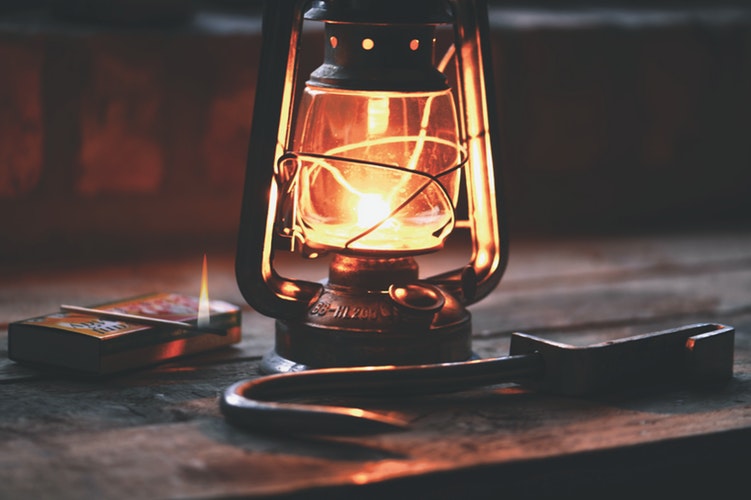How to Build a DIY Oil Lamp

When the lights go out in a survival situation, you’re going to have to create a source of light so that you can see what you’re doing and find your way around at night.
Having a flashlight is one way to accomplish this, but then again, that flashlight runs on battery power, and when your batteries run out, so does your source of light.

As an alternative source of light, you can turn to a method that has been practiced as far back as Roman times: making an oil lamp.
An oil lamp will produce far more light than your typical candle would, and it runs on olive oil (or other vegetable oil) rather than kerosene or petroleum. As a result, it is a very cheap and safe option.
THE BENEFITS OF MAKING AN OIL LAMP

The obvious benefit of making an oil lamp is that it gives you a bright source of light in the event of a power outage or at night. However, another benefit to making an oil lamp in the aftermath of a disaster or grid-down scenario is that you can sell it or trade it as a commodity item.
People will be desperate for whatever source of light that they can get, and since an oil lamp is bright enough to light up an entire room and is safer than a kerosene-based lamp, it’s going to be a very appealing item to many.
If you have enough materials, you can make several of them and then trade them for other essentials such as food, water, ammunition, first aid equipment, and personal hygiene items.
Another benefit is that it lasts a long time. One gallon of olive oil will burn for over ten days straight non-stop. Since you are not likely to be burning the lamp non-stop, that one gallon could potentially last you one or two months.
MAKING THE OIL LAMP

To make the lamp, you will need the following items:
– Olive Oil
– Metal Coat Hanger (for wire)
– Wick
– Glass Jar
– Pliers

Now, let’s learn the steps involved:
Start by bending the hanger until it snaps apart. If you have difficulty getting the hanger to snap with your hands, use the pliers to twist it until it breaks apart.
Next, wrap the wire around the pliers. You’ll want to make the wrapping a little loose so that it is easier to slide the wire off the pliers later, but it should be tight enough that it doesn’t easily slip off. Wrap the wire a minimum of five times; it should make a coil shape.

Next, you need to slide the wire coil off the pliers. If you have difficulty getting it off because you made it too tight, you can use another tool such as a knife or a screwdriver to help.
Put the wire coil into the jar so that the bottom of it sits in the middle, and then have the rest of the length of the wire travel up the outside of the jar.

Bend the wire to form a hook over the edge of the jar to secure it. While forming the hook, make sure that the coil at the bottom does not move so that it is fully sitting on the bottom of the jar.
The purpose of the coil is to hold the wick, which we will get to next. The wick needs to be able to slip through the coil, but if you encounter difficulty with this, you can use your pliers to lightly pry open the top part of the coil so that it will slip through more easily.

Once you have fed your wick down the entire length of the coil, you need to secure it. Use your pliers again to pinch the top of the coil so that the wick cannot fall all the way through.
Don’t make this too tight as it will make it more difficult to feed the wick through again later, but it has to be tight enough so that the rest of the wick does not fall through.
If there is any excess wick, you will need to get rid of it. If you don’t, it will cause too much smoke and the flame will be excessively large. But on the other hand, if there isn’t enough, then the flame won’t be big enough to light up the whole room.
Next, pour olive oil into the jar and continue pouring until it covers the top of the wick. Once the entire wick is soaked in olive oil, you can light it up. Olive oil will not catch a flame as fast as kerosene or petroleum so it will take slightly longer to light. Always be careful while handling fire.
Congratulations! You now have a source of light that will brighten up your house when the power is down or light up your campsite at night. Like we mentioned earlier, olive oil lamps are also a great commodity and bartering/trading item in a grid-down scenario.
Now that you have seen how simple (and cheap) they are to make, you can see that it could be wise to make at least four or five of them that you can set aside and keep in your bartering stockpile.
The next step is to practice these steps yourself, and soon you’ll have your own oil lamp!
